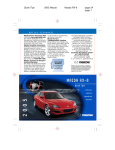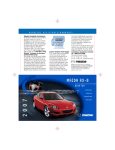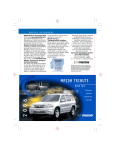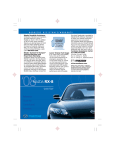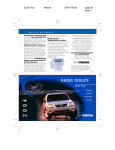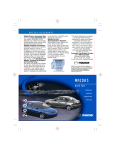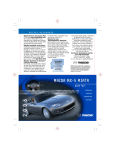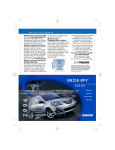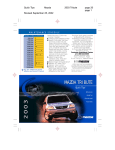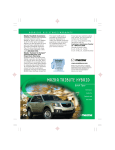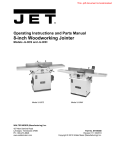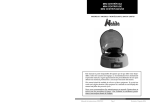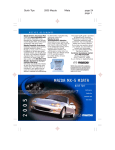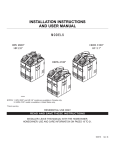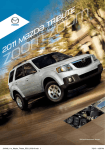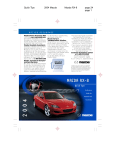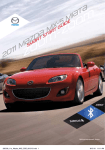Download Mazda RX-8 Quick Tips
Transcript
DRIVER ASSURANCE Mazda Drivers Assurance Plan Check out www.mymazda.com, the website dedicated to you. Manage your maintenance records, receive valuable offers, see the latest accessories and much more! Mazda Roadside Assistance Exhilaration, liberation and inspiration are great reasons to drive a Mazda car, truck, SUV or minivan. In addition to all the other great standard features, you also get peace of mind, our Emergency Roadside Assistance Plan, it’s just a phone call away, 24 hours a day, 365 days a year, call 1-800-866-1998. Mazda ‘’bumper-to-bumper” Limited Warranty We design and build every Mazda to give you driving pleasure now and far down the road. We’re so confident in our quality that we cover the entire vehicle against defects in materials and workmanship for 48 months or 50,000 miles, whichever comes first. Mazda Service Transportation Solution Being without your Mazda may put a crimp in your day, if you do ever have to take your Mazda in for repairs don’t worry, you’re covered. With the Mazda Transportation Solution, you will be given a loaner car at no charge when your Mazda vehicle is in for warranty repairs. For all the details, see your Mazda Dealer. This Quick Tips® guide is provided by Mazda North American Operations to make your Mazda ownership experience more convenient. It is not intended to replace your Owner’s Manual. If you have any questions about your vehicle, you are invited to contact your local dealer. Or if you need additional help, feel free to call our Customer Assistance Center at 1-800-222-5500 Monday through Friday, 8 a.m.- 4 :45 p.m., Pacific 9 a.m.-5:45 p.m., Eastern/Central Unleaded Gasoline 91-octane only, 15.9-gallon/ 60.0-liter tank ©2006 Calcar, Quick Tips® is a trademark of Calcar, made in USA 8/05 32.95M DOT Mazda North American Operations reserves the right to change product specifications at any time without incurring obligations. 9999-95-079C-06QT MAZDA RX-8 Quick Tips ® Reference Guide for 2006 Controls and Functions ® DRIVER’S VIEW 1 2 3 4 5 6 7 8 9 10 7 6 C F E H 8 9 x1000r/min 11 L 1 0 H OIL-P TRIP A DOWN 1 O.O 8 P R N D M DOWN ON OFF VOL 34 10 5 4 3 2 12 35 13 14 16 RES ACCEL SET MODE CANCEL SET COAST CLK FM/AM SAT CD SEEK TRACK APC UP DISP AMB LOAD PUSH POWER UP TAPE/MD 1 2 DISC DISC VOL 3 4 RPT PROG RDM TUNE/AUTO-M 0 5 6 SCAN TEXT/AUDIO CONT 1 2 A/C 3 4 MODE 15 6 17 18 19 20 21 31 30 29 27 28 27 32 33 22 36 26 25 23 Getting Started RX-8 Quick Tips® are designed to quickly familiarize you with some important features of your RX-8 This Driver’s View tab is your index to the Quick Tips®, locate the item you would like to learn more about and then turn to the listed tab Be sure to see the tab called Getting Started, this section contains important operating tips about your RX-8 Items identified in blue text call out important information 24 1. Power window switches, see Switches 2. Power door locks, see Locks 3. Dual power mirrors, see Switches 4. Instrument panel lighting, see Getting Started 5. Turn signal/lighting control lever, see Driver Controls 6. Air vents 7. DSC Dynamic Stability Control System*, see Getting Started 8. Audio control switches*, see Driver Controls 9. Tire pressure monitoring system, see Getting Started 10. Horn/Air bag 11. Cruise control, see Driver Controls 12. Wiper/washer control lever, see Driver Controls 13. Clock, see Audio Systems 14. Information display, see Owner’s Manual 15. Hazard warning switch, Press on/off 16. NAVI system*, see Owner’s Manual 17. Ambient temperature display 18. Audio system, see Audio Systems 19. Passenger air bag off indicator, see Seats 20. Climate control panel, see Climate Controls 21. Gearshift lever (A/T)*, see Transmission 22. Parking brake lever, see Console 23. Cup holders 24. Accessory socket 25. Console, see Console 26. Seat warmer switches*, see Console 27. Steering paddle switches (A/T only)*, see Transmission 28. Tilt steering-wheel lever, see Driver Controls 29. Storage 30. Hood release handle 31. Remote trunk-lid release Push to open trunk 32. Power window lock switch 33. Remote fuel-door release Use unleaded gasoline, 91-octane only 34. Open/close NAVI screen* 35. NAVI screen tilt* 36. NAVI system remote control* *Denotes optional equipment Always check the Owner’s Manual for more operating information and safety features Driver’s View Getting Started GETTING STARTED 4 Advanced 3 keyless entry/ start system* Advanced key must be carried 5 by driver to operate properly Refer to Owner’s Manual for additional instructions Tip: System may not operate correctly if vehicle is near equipment such as wireless pay devices located at some gas stations, if this occurs, use auxiliary key to lock/unlock and start vehicle Advanced keyless system customization Your authorized Mazda Dealer can customize your system if desired with features such as auto-lock: After exiting the vehicle after driving, the car will automatically lock Passenger’s door request switch: Press (6) on passenger’s door; both doors unlock simultaneously Trunk request switch: Press (7) located above license plate, only trunk will open, doors do not 7 lock/unlock 6 Advanced key transmitter: Locking doors Press button (2) for driver’s Driver’s/passenger’s door request door; press again within a 3 switch: Press (6) once on either seconds to unlock passenger’s door door to lock both doors Press and hold button (3) Advanced key transmitter: for more than 1 second to Press button (1); pressing again open trunk within a few seconds causes doors Activating panic alarm to relock and horn to beep Panic alarm: Press and hold Unlocking doors/ button (4) for more than 1 second; opening trunk horn sounds, hazard warning Driver’s door request switch: Press lights flash; to stop, press any (6) to unlock driver’s door; press remote button again within 3 seconds to unlock both doors Starting engine Press start knob (8); when KEY indicator (green) illuminates on 9 8 9 instrument cluster; turn start knob (8) to START position to start engine Tip: Engine will not start if trunk is open and advanced key is placed in trunk Auxiliary key operation If advanced key cannot be used due to a malfunction or dead battery, use auxiliary key (5) to lock/unlock doors, trunk and to start vehicle To start vehicle: Remove start knob cover (8) by pressing both side release buttons (9) while pulling; insert auxiliary key into key cylinder and turn to start engine Tip: Do not place advanced key on or around dashboard, storage compartments such as glove box or in open trunk, engine may not start or warnings may activate Turning off engine Turn start knob to ACC position to turn engine off, push in and turn start knob to LOCK position Tip: Vehicle battery may be discharged if start knob is left in ACC position Always put vehicle in Park (P), set parking brake and turn start knob to LOCK position when exiting vehicle System operation warnings KEY indicator light flashes (green) indicates advanced key transmitter battery power is low KEY indicator light illuminated continuously (red) indicates system malfunction, and auxiliary key should be used, have vehicle inspected at an Authorized Mazda Dealer as soon as possible 1 2 LOCK ON S TA RT C AC PUSH For additional information on customizable features, see Owner’s Manual *Denotes optional equipment Tip: When using advanced keyless system, system will beep as confirmation of lock/unlock requests, system will also beep if start knob is left in ACC position, advanced key has been left in vehicle or if advanced key is removed from vehicle while vehicle is running For additional system operation warnings, see Owner’s Manual Replacing battery See Owner’s Manual for complete instructions Cautions on use To avoid damage to advanced key, do not allow any severe impacts or contact with liquids, do not place heavy objects on advanced key and do not leave advanced key exposed to direct sunlight or high temperatures See Owner’s Manual for all cautions and warnings Always check the Owner’s Manual for more operating information and safety features Getting Started Getting Started GETTING STARTED Starting tips To keep engine in top condition, engine coolant temperature gauge needle should reach the middle normal operating range between C and H before turning engine off, do not turn OFF a cold engine if possible In the unlikely event that the engine does not start, try the following procedure: 1. Depress and hold the accelerator pedal to floor and crank engine for 7-8 seconds 2. Release ignition switch 3. Start the engine, releasing accelerator pedal If the engine starts while in step 1, the engine will rev up, in that case, release your hand immediately from the ignition key and your foot from accelerator pedal If the engine still fails to start, have your vehicle inspected at the dealer • Do not keep holding ignition switch in START position for more than ten seconds, if the engine does not start, it may result in a weakened or dead battery • Please avoid racing engine or sudden take off right after starting the engine • If these starting tips are not followed, engine may be DAMAGED as a result Short trip driving procedure For any trip that is too short for the engine to reach normal operating temperature, (needle in middle of temperature gauge indicates normal temperature), the following procedure should be followed**: 1. Start engine 2. Move vehicle 3. Warm engine for 5-minutes at idle 4. Raise engine speed to 3000 RPM for 10-seconds 5. Return to idle 6. Turn off engine Tip: Warming up engine improves engine life Instrument panel lighting With headlights on: To brighten/ dim turn thumbwheel up/down Maximum illumination: Rotate thumbwheel upward until click is heard; instrument cluster and information display illumination color goes from red to white Headlights/parking lights OFF: Instrument panel lighting defaults to maximum brightness Headlights/parking lights ON: Illumination changes brightness with dimmer switch adjustment Rear doors For a rear occupant to exit with a front passenger: 1. Front occupant must release seatbelt 2. Front occupant must open door 3. Open rear door For a rear occupant to exit without a front occupant: 1. Release front seat to forward position 2. Unlock and open front door 3. Open rear door Tip: Close rear door first, then front door; damage may occur otherwise Instant Mobility System emergency flat tire repair kit (IMS) Temporary spare tire is not equipped with your Mazda, if tire repair is required, repair tire with emergency flat tire repair kit, see Owner’s Manual If a temporary spare tire is required, consult your Authorized Mazda Dealer Tire pressure monitoring system Warning light illuminates for a few seconds when ignition is on If tire pressure is too high or low, or tire temperature is too high warning light will illuminate Traction Control System (TCS)*/Dynamic Stability Control (DSC)* DSC light may occasionally flash while driving, this indicates that the DSC was performing a correction to help maintain your best vehicle control, if DSC light remains on, see your Mazda Dealer If DSC light remains on after disconnecting battery or jumpstarting, you will need to perform a Steering Angle Sensor calibration procedure, after battery power is restored: Ignition ON; turn steering wheel to full left lock position; then full right lock position; turn ignition OFF, then ON *Denotes optional equipment **Moving vehicle at a car wash or moving vehicle to access another vehicle would be considered a short distance Always check the Owner’s Manual for more operating information and safety features Getting Started Instrument Cluster INSTRUMENT CLUSTER GAUGES 1. Fuel gauge 2. Engine coolant temperature gauge If above normal range, stop vehicle and turn off engine, check coolant level when safe 3. Speed unit selector Select km/h or mph 4. Tachometer 5. Engine over-rev warning buzzer The rotary engine design allows RPM ranges of up to 7500 RPM (A/T) and 9000 RPM (M/T), if you exceed a given RPM, a warning buzzer will remind you to up-shift to the next higher gear Always obey all local speed limits and traffic signs 5 6 4 2 1 3 78 9 10 6 C F E H 8 9 7 x1000r/min 10 L 5 OIL-P 4 3 2 1 0 6. Speedometer 7. Odometer/trip odometer selector Press and hold to reset selected trip meter 8. Odometer/trip odometer TRIP A H 1 O.O P R N D M 8 9. Engine oil pressure gauge, Indicates normal engine oil pressure when needle is halfway between L and H with engine running 10. Gear indicator (A/T only)* Displays current gear of Sport A/T during manual and automatic shift modes WARNING LIGHTS • Low fuel • Turn signals/hazard warning on • Anti-lock Brake System (ABS) ABS malfunction, normal brakes only, dealer inspection required • Automatic transaxle Dealer inspection required if light remains on • High beams on • Charging system Dealer inspection required • Tire pressure monitoring system, see Getting Started • Lights on • DSC OFF Dynamic Stability Control/Traction Control System* off System turned off manually • • • • • • • • • Traction Control System (TCS)*/Dynamic Stability Control (DSC)*, see Getting Started Cruise control on, Amber light: Cruise control system activated Green light: Cruising speed set; see Driver Controls Brake system Parking brake on/low fluid level Check engine Dealer inspection required EBD malfunction Dealer inspection required Immobilizer system, see Locks KEY*, see Getting Started Low washer fluid level* Headlight auto leveling malfunction • • • • • • Power steering malfunction Dealer inspection required if light remains on Engine coolant level Air bag readiness Front, side and curtain air bag malfunction; warning light constantly flashes or stays on or never comes on with ignition on, dealer inspection required Door ajar Always fasten safety belts Engine oil level Indicates low engine oil if illuminated; pull over to a safe location; turn engine off and check engine oil level when engine is cool, add engine oil if necessary *Denotes optional equipment Always check the Owner’s Manual for more operating information and safety features Instrument Cluster Driver Controls DRIVER CONTROLS 1 2 3 1 2 4 3 6 5 8 7 Turn signal/lighting control lever OFF = Lights off = Tail, parking and dashboard lights on: Rotate knob (1) to first notch = Tail, parking, dashboard and headlights on: Rotate knob (1) to second notch High beams on/off: Push forward/ pull back to detent To flash high beams: Pull back slightly and release Turn signals right/left: move lever up/down = Fog lights on: Rotate (2); functions only with headlight low beams on Tip: Headlights switch off, parking lights remain on, if lights are left on and switch is in lock position or key removed Wiper/washer control lever Intermittent wiper: One click down To change interval speed: Rotate inner ring (3) Normal wiper speed: Two clicks down Fast wiper speed: Three clicks down Single wipe: Push stalk up Washer: Pull stalk back Cruise control Operates above 19 mph To activate: Press and release ON/OFF (1) To set speed: Press and release SET/COAST (3) at desired speed To accelerate: Press and hold RES/ACCEL (2); incremental acceleration: Press and release (2), each tap = plus 1 mph To decelerate: Press and hold SET/COAST (3), release at desired speed; or tap brake pedal, press and release (3) at desired speed; incremental deceleration: Press and release (3), each tap = minus 1 mph To cancel: Tap brake pedal, clutch pedal (manual transaxle) or press CANCEL button (4) or ON/OFF (1) Return to preset speed after CANCEL button or braking: Press and release RES/ACCEL button (2) Steering-wheel audio controls To increase/decrease volume: Press (5) Radio: Press (6) to select preset stations Cassette/CD/MD: Press (6) to select next selection/track Press (7) to select FM1, FM2, AM, CD, SIRIUS 1/2/3, tape and MD mode Press (8) to mute Tilt steering-wheel lever Pull lever located under steeringwheel down to unlock column, position tilt angle steering column position WARNING: Do not adjust steering-wheel while driving, you can lose control of vehicle *Denotes optional equipment Always check the Owner’s Manual for more operating information and safety features Driver Controls Locks LOCKS Key Operates ignition and all locks Tip: Use key number plate to purchase new key; store in safe place 1 Retractable key Unfold key: Press (1) Fold key: Press (1) and rotate key into holder Auxiliary key* See Getting Started 1 2 LOCK AUTO Remote keyless entry system* Functions only 2 with ignition in 3 OFF position and 5 key removed from 4 ignition cylinder To lock doors: Press button (2); pressing again within 5 seconds causes doors to relock and horn to beep To unlock: Press button (3) for driver’s door; press again within 3 seconds to unlock passenger’s door Press and hold button (4) for more than 1 second to open trunk Panic alarm: Press and hold button (5) for more than 1 second; horn sounds, hazard warning lights flash; to stop, press any remote button Advanced keyless entry/ start system/auxiliary key* See Getting Started Immobilizer system Prevents engine from running unless coded key is used, see Owner’s Manual WARNING: Never leave children unattended with key in vehicle or access to keys Manual door locks Lock button To lock: Press front of button (1) toward door handle To unlock: Pull front of button away from door handle Tips: Doors can be locked with key in ignition (chime sounds to alert you to key in ignition) Locking doors with inside door lock knob will not arm system Power door locks Master front door lock switches To lock/unlock all doors: Press bottom/top of switch (2) To lock doors without key: With door open, press bottom of door lock switch, exit car, close doors To unlock: Use key to unlock driver’s front door, rotate key to counterclockwise position for more than one second to unlock other doors *Denotes optional equipment Always check the Owner’s Manual for more operating information and safety features Locks Switches SWITCHES 1 L R 2 5 LOCK AUTO 3 4 Dual power mirrors Ignition switch must be in ACC or ON position Switch is on driver’s door To adjust left/right mirror: Press selector switch (1) left/right, press switch (2) in direction of desired movement Tip: To lock mirrors in place, move selector to center position Power window switches Ignition switch must be in ON position Front windows controlled from the driver’s armrest; passenger door has a separate switch Driver’s window One-touch-down: Push down AUTO switch (3) firmly and release, window goes down all the way; pull switch back briefly to stop; press lightly and hold for normal operation Passenger window switch Press button (4) down and hold to open; pull back and hold to close Power window lockout switch Press button (5) down until it clicks, only driver’s window operates; press again and passenger windows function again *Denotes optional equipment 4 5 6 9 2 1 3 Front Console 1. Console Press button (9) and slide cover rearward until it stops to access cup holders (2), then flip cover up to the right to access accessory socket (3) 2. Cup holders 3. Accessory socket 4. Parking-brake lever To engage: Pull up To release: Pull up slightly while depressing button at front of lever, lower hand brake lever 5. NAVI system remote control* 6. Seat warmer switches* Press on/off switch; indicator light on when activated Tip: When activated, heated seats turn on when seat temperature is below approximately 80oF and turn off when seat temperature reaches approximately 100oF or above 10 7 8 Rear Console 7. Storage To open storage box: Squeeze latch (10) and pull lid downward Tip: Storage box can be removed to allow convenient loading of long objects through trunk See Owner’s Manual for complete details and warnings 8. NAVI DVD* Always check the Owner’s Manual for more operating information and safety features Console HomeLink® HOMELINK® 1 2 3 HomeLink Wireless Control System* Located on rear view mirror To program or reprogram: Ignition must be off; hold transmitter for the device to be programmed between 1-3 inches to HomeLink®; press transmitter button and desired HomeLink® button (1) simultaneously until HomeLink® indicator light goes from slow to rapid flashing ® 1 2 1 DOOR OFF SLIDE 3 5 TILT 7 6 3 Turn ignition on; verify device operation by pressing HomeLink® button (1) that was just programmed; repeat procedure for other buttons Rolling code synchronization procedure Refer to your garage door opener or device instruction manual to confirm your system is equipped with a rolling code feature Tip: This procedure is easier done with the assistance of another person To synchronize: Press programming button on garage door opener motor; press and release the programmed HomeLink® button 2 times within 30 seconds of pressing the garage door opening motor programming button Some devices may require you to press and release a third time to complete programming procedure 1. Map/reading light Press on/off 2. Interior light switch DOOR = light on when door open ON = light always on OFF = light always off 3. Front interior light 4. Rear interior light 5. Sunglass holder Press concaved lip then open 6. Moonroof tilt switch* Press rear of switch to tilt rear of sunroof Press front of switch to close 7. Moonroof slide switch* Press rear of switch to open sunroof Press front of switch to close Illuminated visor mirrors Mirrors lighted when covers open; off when closed Auto-dimming rear view mirror Auto-dimming function changes are based on outside lighting conditions and if bright headlights are visible in rear view mirror Press on (2), off (3) 2 OFF DOOR ON 4 *Denotes optional equipment Always check the Owner’s Manual for more operating information and safety features Interior Lights Transmission TRANSMISSION M (Sport A/T manual shift mode*) Move shifter from N D to M to engage M D manual shift mode, M will be illuminated for manual mode on shift position indicator located in the instrument panel Manual shifting of transmission is achieved by moving shifter back to upshift and forward to downshift, move shifter from M to D to engage automatic shift mode Gear indicator (A/T only)* Illuminated numeral of gear indicator located in the instrument panel displays current gear in Automatic and Manual shift modes 1 P R Automatic transmission* P = Park To move gearshift from Park:Press firmly on brake pedal, then move gearshift to gear selection R = Reverse N = Neutral No gear engaged D (Overdrive) For normal driving: Shifts through all forward gears automatically Manual transmission* Depress clutch pedal to start engine and change gears, push shifter downward when selecting reverse gear DOWN UP UP 2 2 Steering shift switches (A/T only)* To upshift: Pull up switch (2) To downshift: Press down switch (1) Tip: Steering shift switches are marked UP and DOWN WARNING: Placing shift lever in P position without setting parking brake may not hold vehicle, always set parking brake WARNINGS: Do not shift into 1st above 20 mph or clutch failure could occur Resting your foot on clutch pedal while driving and using the clutch to hold your vehicle at a stand still while waiting on a hill may reduce clutch life *Denotes optional equipment Always check the Owner’s Manual for more operating information and safety features Transmission 1 DOWN Seats SEATS Manual controls 1. Fore-aft adjustment Lift lever and hold, slide seat, release lever 2. Raise/lower driver’s seat Pull/push lever and release 3. Seatback angle To adjust: Lift and hold lever, lean forward or backward, release lever Tip: Pull up lever behind passenger’s front seat to lower seatback for easy entry/exit from rear seat 1 2 Power driver’s seat* 4. Raise/lower front of seat cushion Pull/push front of switch vertically Fore/aft adjustment Slide switch horizontally Raise/lower rear of seat cushion Pull/push rear of switch vertically 5. Seatback angle Press front/rear of switch 6. Lumbar adjustment* Press front/rear of switch to increase/decrease firmness 3 Tip: Side-impact air bags deploy from outboard side of driver and front passenger seatbacks 6 4 5 WARNINGS: Do not adjust seats while driving Safety belts must always be worn when vehicle is in motion Air bags are supplemental and do not replace safety belt usage Always wear your safety belt and properly secure children 12 and under in the rear seat Never place rear-facing infant-safety seat in front of any air bag, an infant is in serious danger of being injured or killed If you must install a forward-facing child-safety seat in the front seating position, move vehicle seat as far back as possible Use age appropriate child restraints, see Owner’s Manual and state or province laws Child-safety seat To install in rear outboard seats: Use dual locking mode retractor seat belts; see Owner’s Manual for proper installation and child seat tether and LATCH system instructions Passenger air bag deactivation indicator light Front air bag deactivation indicator light provides current status of front passenger air bag and pretensioner system If total seated weight on front passenger seat is less than approximately 66 lb., front passenger air bag deactivation indicator light illuminates, air bag/pretensioner will not deploy/activate in an accident If the total seated weight is greater than approximately 93 lb., light does not illuminate, and the air bag/pretensioner will deploy/activate Seat warmer*, see Console in an appropriate accident, see Owner’s Manual for additional information on this feature and the air bag system Safety belt emergency locking mode Belts lock only on hard acceleration, braking, cornering or impacts of about 5 mph or more Automatic locking mode (front passenger and all rear safety belts only) Must be used when installing child-safety seat To activate: Pull webbing fully out of retractor until click is heard; belt will only tighten To disengage: Unbuckle belt and allow webbing to retract fully *Denotes optional equipment Always check the Owner’s Manual for more operating information and safety features Seats Climate Controls CLIMATE CONTROLS 2 1. Air flow selections = air to dash 0 = air to dash and floor 2. 3. 4. 5. 2 1 3 Trunk To open: Use key, remote trunklid release, remote keyless entry fob or advanced keyless entry trunk request switch* Remote trunk-lid release, see Driver’s View 1. Instant Mobility System emergency flat tire repair kit (IMS)†, see Getting Started 2. Jack/jack handle Lift cover to access jack/tools 3. Lug wrench 3 2 A/C 3 4 = air to floor = air to floor and windshield Fan control Rotate knob between 0 (OFF) and 4 (HIGH) Temperature control Cooler/warmer = rotate knob counterclockwise/clockwise A/C = air conditioner Press to turn on/off Air intake control = recirculate inside air; use for maximum cooling = fresh air WARNING: Do not use position in cold weather, windows may fog and hamper vision 4 1 1 MODE 7 5 6 6. Rear window defogger Press on/off; shuts off with ignition; also operates heated side mirrors* Control positions for maximum cooling A/C ON, air to dash, recirculate, fan position 4 (HIGH) Control positions for maximum defrost Fan to maximum, temperature to maximum hot, selected Tips: To help prevent windshield fogging in humid weather, select before starting engine To prevent moisture buildup, never drive with system off Objects placed under the front seats may interfere with air flow to the rear 7. Front windshield defogger A/C switches ON and air intake switches to fresh air Tire economy and tips Check tire pressure regularly when tires are cold, maintain correct front-end alignment and tire balance; rotate tires at the mileage shown in the Maintenance Guide; see Owner’s Manual for rotation chart Tire pressure P225/55R16 94V, P225/45R18 91W Front/rear: 32psi cold Tips: Correct tire pressure promotes proper handling and ride comfort If you experience pull/drift while driving, possible causes may be road crown, tire pressure, or wheel alignment The suspension is sport-tuned with firmer ride for optimum handling and response Tire chains*† Tire chains can damage aluminum wheels; use on steel wheels only Tips: Use only SAE class “S” chains, install only on rear tires; install as tightly as possible and retighten after driving 1/4 -1/2 mile; chains may affect handling Never exceed 30 mph with tire chains Luggage compartment internal safety release Allows you to escape should you become locked in trunk Slide illuminated release lever in direction of arrow; lever will glow if it has been exposed to light Located on interior trunk lid *Denotes optional equipment † See Owner’s Manual Always check the Owner’s Manual for more operating information and safety features Trunk Audio Systems AM/FM STEREO/CASSETTE/CD 1. Power/Volume Press to turn on/off; rotate to increase/decrease volume Tip: Press (8) and (9) together to turn radio on 2. Repeat Press to replay current CD/ tape selection † 3. Disc up Press to skip forward to beginning of next CD † 4. Disc down Press to skip back to beginning of previous CD 5. Tune/Auto-Memory Tune: Rotate counterclockwise/ clockwise for lower frequency/ higher frequency Radio: Press and hold until a beep sound is heard; system automatically scans and temporarily stores six strong stations in each band; press again to cancel 9 10 11 7 A B SET CLK 8 12 FM/AM SAT CD 13 TAPE/MD DISP 14 AMB MINI DISC LOAD PUSH POWER SEEK TRACK APC 1 2 DISC DISC 15 VOL 3 4 RPT PROG RDM TUNE/AUTO-M 6 5 6 SCAN 16 17 18 17 TEXT/AUDIO CONT 4 3 2 1 24 9. SAT* Satellite ready capability For additional information, see Owner’s Manual 10. CD slot 11. 6. SEEK/TRACK/APC Radio: Press / to automatically seek higher/lower frequency 12. CD: Press / to select next/previous track 13. Tape: Press / to automatically advance tape to beginning of next selection/ replay selection; to stop this 14. operation, press button again 15. 7. LOAD* To load multiple discs: Press and hold LOAD (7) until 16. beep sound is heard; insert CD 17. when “In” is displayed 18. To eject disc: Press Eject (14) To eject specific disc: Press and 19. hold Eject (14) until beep sound is heard; within five seconds press the desired tray number 1-6 (15) 20. 8. FM/AM Press to select between FM1/FM2/ AM station preset buttons (15) 5 23 22 21 20 19 21. Text/Audio Control Audio control: Press to select BASS/MID/TREB/FADE/ BAL/BEEP ON/ALC OFF/ ALC LEVEL 1, 2, 3/AUDIO PLT ON**; rotate right/left to adjust selected feature Tip: Audio volume CD adjusts automatically Press to play CD depending on vehicle speed Tape*/MD* (Standard audio system) or Press to play Mini-disc Player/ noise (Bose audio system) cassette tape 22. Fast forward DISP* Press to fast forward through Press: Changes display during a track MD play 23. Reverse CD eject button Press to reverse through a track Memory preset buttons 24. Program Random† To set: Tune to station, press and Press to enable/cancel hold until beep sound is heard Clock To set: With ignition in ACC or ON Mini Disc slot* position, press (B) and hold until Eject button* beep sounds; 12 hr/24 hr will be Cassette door* displayed; press (A) to select; press Dolby® Noise Reduction* (B) again while selection is flashing: Reduces tape noise and hiss; Hr ADJUST displays; press (A) to press to activate/deactivate select hr; press (B) when done, Scan do the same to set minutes Press to briefly sample next *Denotes optional equipment audio system only listenable selections; functions **Bose † For use with cassette tape player, in all modes MD player, or CD changer* Always check the Owner’s Manual for more operating information and safety features Audio Systems Under Hood UNDER HOOD 11 1 3 12 10 9 8 7 2 5 6 4 1.3-liter 13B RX-8 rotary engine precautions Check engine oil level when refueling Rotary engine design uses an oil injection system in addition to lubrication of internal parts It is important to maintain proper oil level *Denotes optional equipment † See Owner’s Manual Break-in period First 600 miles: Drive at varying road and engine speeds; avoid full throttle, rapid acceleration or kick-down of transmission Do not use special “break-in” oils Anti-lock Braking System (ABS) ABS automatically reduces hydraulic pressure to any wheel on the verge of locking up You may feel a slight pulsing of the brake pedal and hear a clicking noise; this tells you the ABS is functioning properly; increase pressure on pedal for maximum braking Tips: Maintain constant pressure on the brake pedal Do not pump the brakes ABS self test A self-diagnostic test is performed when starting; you may feel some brake pedal pulsation and hear some noise, this is normal 6. Brake/Clutch* fluid reservoir 1. Engine cover Fill to MAX mark with DOT 3 Remove to gain access to fluid; check with cap on engine oil dipstick (2) and engine oil filler cap (3) 7. Hood latch To remove cover: Pull up firmly Push hood latch to the right, on front corners; then pull open hood toward front of vehicle 8. Hood support rod 2. Engine oil 9. Engine coolant reservoir dipstick Level should be between F and Full With engine L lines when cold OK cover (1) WARNING: Never remove removed, check Low coolant reserve tank cap engine oil level while engine is running or 5 to 10 minutes hot; you could get burned after warming up engine; fluid 10. Battery level should be between full To access: Remove engine and low marks on dipstick cover (1) first, then remove 3. Engine oil filler cap battery cover (12), pull up back SAE 5W-20 of battery cover and remove Remove engine cover (1) to 11. Windshield washer access engine oil filler cap reservoir 4. Fuse block Fill with windshield 5. Air filter washer fluid Normal maintenance notes Rotate tires every 7,500 miles or sooner if needed; replace cabin air 15,000 miles A B E filter every 25,000 miles or 24 months 22,500 miles A Replace (FL22)* engine coolant 30,000 miles E A B C every 120,000 miles or 10 years 37,500 miles A D A. Change: Engine oil/replace filter Lube: Locks and hinges 45,000 miles A B B. Inspect: Disc brakes 52,500 miles A E C. Inspect: Drive belt, fuel lines, 60,000 miles F A B C hoses, and connections, brake lines and hoses, steering 67,500 miles A operation and linkages, front A 75,000 miles and rear suspension ball joints, A 82,500 miles driveshaft dust boots, chassis and body bolts, exhaust system A 90,000 miles heat shields, cooling system, † and bolts and nuts on seat Unique driving conditions Every 5,000 miles change oil/filter, D. Replace: Air filter, spark plugs inspect coolant level, lights, brake/ E. Clean: Air filter clutch fluid, tire pressure/wear, F. Replace: Manual transmission and locks/hinges and washer fluid rear differential oil, engine coolant 7,500 miles A Always check the Owner’s Manual for more operating information and safety features














